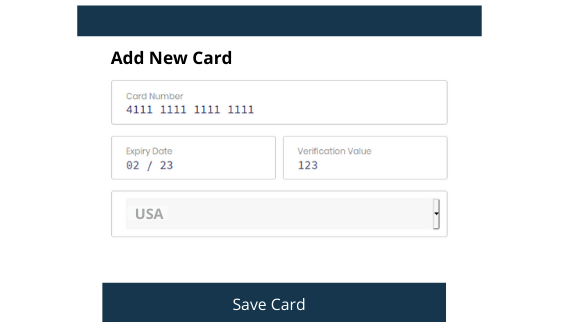Laravel 8 Stripe card management

Laravel stripe card management is the process to manage stripe payment methods from laravel dashboard only.
Today we will learn how we can manage stripe cards for customers with Laravel. I am using laravel 8.
We will be able to manage stripe cards from laravel dashboard
- Add new card
- Delete card
- Set default card
- Retrieve all cards
I assume that you have already set up a laravel project, I am not going to show that process. So, let’s dive into it.
We need a laravel cashier package for stripe card management. Follow the installation steps from the laravel cashier documentation.
composer require laravel/cashier
After successfully setup the cashier with laravel. I hope you already set up the stripe keys in the env file.
STRIPE_KEY=pk_test_DFSLAFDLAFLDSLFDSLFASL STRIPE_SECRET=sk_test_LOREMIPSUMEFDSJFDSJ
Let’s create the payment methods table in our database.
Payment methods table migration
We need a database table called payment_methods to store stripe cards to our database. It will provide us with a fast response.
Schema::create('payment_methods', function (Blueprint $table) {
$table->id();
$table->string('pm_id');
$table->foreignId('user_id');
$table->string('card_number');
$table->string('brand')->nullable();
$table->string('exp_month');
$table->string('exp_year');
$table->string('type')->default('card');
$table->tinyInteger('default_method')->default(0);
$table->timestamps();
});
Create a Payment Methods Controller
Create the payment method controller to manage all activities related to stripe card management with laravel. We can make it a laravel resource controller.
<?php
namespace App\Http\Controllers;
use App\Http\Controllers\Controller;
use Illuminate\Http\Request;
class PaymentMethodsController extends Controller
{
/* GET
/payment-methods */
public function index(Request $request) {}
/* GET
/payment-methods/create */
public function create(Request $request) {}
/* POST
/payment-methods */
public function store(Request $request) {}
/* GET
/payment-methods/{id}/edit */
public function edit(Request $request) {}
/* PUT
/payment-methods/{id} */
public function update(Request $request) {}
/* GET
/payment-methods/{id} */
public function show(Request $request) {}
/* DELETE
/payment-methods/{id} */
public function destroy(Request $request) {}
}
Add route for payment methods.
Route::resource(‘payment-methods’, PaymentMethodsController::class);
So, it’s done now. Let’s start the action. First thing is to add a new card.
Add new card
When we click on the add card button we will call the create method in the controller.
<a href=”{{ route(‘payment-methods.create’) }}”>Add Card</a>
And in the create method we will use the setupIntent cashier method then return form view. It will set up the stripe card elements with secret from available intent.
Public function create( Request $request ) {
$user = auth()->user();
return view('card-form',
['intent' => $user->createSetupIntent()] );
}
We will pass the intent to the card button available in the card form. To set up the stripe js you can follow this guide.
<button id="card-button" type="submit" data-secret="{{ $intent->client_secret }}"> Save Card </button>

Create the relationship between PaymentMethods and user
class User extends Authenticatable {
Public function localPaymentMethod() {
return $this->hasMany(‘App\Models\PaymentMethod’, ‘user_id’, ‘id’);
}
}
We will use localPaymentMethod function because we are using laravel cashier and we have already paymentMehods function for user model.
After submitting this form it will go to the store method of the controller. The createOrGetStripeCustomer cashier method helps us to create new customers to the stripe if this user does not exist there. But if it is already saved as a customer to the stripe then it will just return the customer data.
Public function store( Request $request ) {
$user = auth()->user();
$user->createOrGetStripeCustomer();
$paymentMethod = $request->payment_method;
$user->addPaymentMethod($paymentMethod);
$this->saveRecord([
‘pm_id’ => $paymentMethod
]);
if ( !$user->hasDefaultPaymentMethod() ) {
$user->updateDefaultPaymentMethod($paymentMethod);
$this->setDefault($paymentMethod);
}
return redirect()->route("payment-methods.index")->with([‘success’ => ‘Card is successfully saved!’]);
}
Protected function saveRecord( $col ) {
$user = auth()->user();
$paymentMethod = $user->findPaymentMethod($col[‘pm_id’]);
$user->localPaymentMethod()->updateOrCreate($col, [
'card_number' => $paymentMethod->card->last4,
'brand' => $paymentMethod->card->brand,
'exp_month' => $paymentMethod->card->exp_month,
'exp_year' => $paymentMethod->card->exp_year,
'type' => $paymentMethod->type
]);
}
Protected function setDefault( $paymentMethod ) {
$user = auth()->user();
$user->localPaymentMethod()->where(‘default_method’, 1)->update([
‘default_method’ => 0
]);
$user->localPaymentMethod()->where(‘pm_id’, $paymentMethod)->update([
‘default_method’ => 1
]);
}
Here is the logic that the first card will be the default card after that user can add as many as want and set default to another card.
Now, let’s list all the cards
Cards Listing
public function index(Request $request) {
$user = auth()->user();
$cards = $user->localPaymentMethod;
return view(‘card-list’, [‘cards’ => $cards]);
}
Delete the card
public function destroy(Request $request) {
$user = auth()->user();
// delete from the stripe with cashier methods
$paymentMethod =
$user->findPaymentMethod($request->paymentMethodId);
$paymentMethod->delete();
// delete from our database
$user->localPaymentMethod()->where(‘pm_id’, $request->paymentMethodId)
->delete();
return redirect()->route("payment-methods.index")->with([‘success’ => ‘Card is successfully deleted!’]);
}
Update the card
We will use the update method to update the default payment method. If you remember we have already created a method called setDefault to set the default payment method. We are going to use that method here.
public function update(Request $request) {
$user = auth()->user();
// update to the stripe
$paymentMethod =
$user->findPaymentMethod($request->paymentMethodId);
$user->updateDefaultPaymentMethod($paymentMethod->id);
// local update to our database
$this->setDefault( $request->paymentMethodId );
return redirect()->route("payment-methods.index")->with([‘success’ => ‘Card is successfully updated!’]);
}
Hope you find this article useful.




